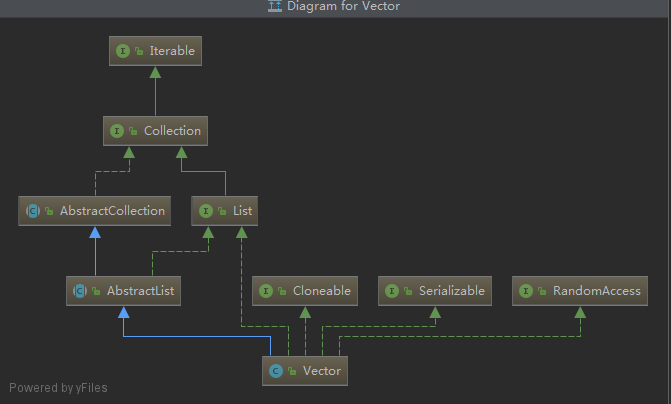一:先看下类的继承关系
UML图如下:

继承关系:
public class Vector<E>RandmoAccess快速随机访问接口
extends AbstractList<E>
implements List<E>, RandomAccess, Cloneable, java.io.Serializable
二:看下成员属性
/**分析:该数组缓冲区是存储vector元素,并且至少足够大到包含vector的所有元素
* The array buffer into which the components of the vector are
* stored. The capacity of the vector is the length of this array buffer,
* and is at least large enough to contain all the vector's elements.
*
* <p>Any array elements following the last element in the Vector are null.
*
* @serial
*/
protected Object[] elementData;
/**分析:vector中实际元素的数量
* The number of valid components in this {@code Vector} object.
* Components {@code elementData[0]} through
* {@code elementData[elementCount-1]} are the actual items.
*
* @serial
*/
protected int elementCount;
/**分析:vector增加的容量capacityIncrement,如果vector实际元素数量大于当前容量,vector将自动扩容,扩容的容量为当前容量加上capacityIncrement。如果没有指定增加的容量,那么vector在扩容时成倍的增长。
* The amount by which the capacity of the vector is automatically
* incremented when its size becomes greater than its capacity. If
* the capacity increment is less than or equal to zero, the capacity
* of the vector is doubled each time it needs to grow.
*
* @serial
*/
protected int capacityIncrement;
/** use serialVersionUID from JDK 1.0.2 for interoperability */分析:版本号
private static final long serialVersionUID = -2767605614048989439L;
三:构造函数
/**分析:无参构造函数vector会初始化一个长度为10的空数组,它的标准容量增量为0(ps:也就是上面提到的capacityIncrement = 0)
* Constructs an empty vector so that its internal data array
* has size {@code 10} and its standard capacity increment is
* zero.
*/
public Vector() {
this(10);
}
/**分析:指定vector初始化长度,构造一个指定的长度空数组,它的标准容量增量为0。
* Constructs an empty vector with the specified initial capacity and
* with its capacity increment equal to zero.
*
* @param initialCapacity the initial capacity of the vector
* @throws IllegalArgumentException if the specified initial capacity
* is negative
*/
public Vector(int initialCapacity) {
this(initialCapacity, 0);
}
/**分析:指定初始化长度和容量增量值
* Constructs an empty vector with the specified initial capacity and
* capacity increment.
*
* @param initialCapacity the initial capacity of the vector
* @param capacityIncrement the amount by which the capacity is
* increased when the vector overflows
* @throws IllegalArgumentException if the specified initial capacity
* is negative
*/
public Vector(int initialCapacity, int capacityIncrement) {
super();
if (initialCapacity < 0)
throw new IllegalArgumentException("Illegal Capacity: "+
initialCapacity);
//初始化长度为传进来长度的空数组
this.elementData = new Object[initialCapacity];
//容量增加值为传进来的capacityIncrement值
this.capacityIncrement = capacityIncrement;
}
/**分析:传入指定的集合,将集合元素赋值给vector
* Constructs a vector containing the elements of the specified
* collection, in the order they are returned by the collection's
* iterator.
*
* @param c the collection whose elements are to be placed into this
* vector
* @throws NullPointerException if the specified collection is null
* @since 1.2
*/
public Vector(Collection<? extends E> c) {
//将集合转为数组,赋值给Object数组elementData
elementData = c.toArray();
//vector长度等于集合长度
elementCount = elementData.length;
// c.toArray might (incorrectly) not return Object[] (see 6260652)
//c.toArray方法返回的数据错误,重新拷贝
if (elementData.getClass() != Object[].class)
elementData = Arrays.copyOf(elementData, elementCount, Object[].class);
}
四:看下主要的方法
1.add()方法
/**
* Appends the specified element to the end of this Vector.
*
* @param e element to be appended to this Vector
* @return {@code true} (as specified by {@link Collection#add})
* @since 1.2
*/
public synchronized boolean add(E e) {
//抽象父类AbstractList的成员变量,修改次数记录
modCount++;
//保证容量足够大
ensureCapacityHelper(elementCount + 1);
//elementCount是当前元素个数,数组下标是从0开始的,所以elementData[elementCount]是当前需要添加元素的位置
//elementCount++
elementData[elementCount++] = e;
return true;
}
分析:这里我们可以看到vector的添加方法,直接加了个synchronized锁,添加方法是线程安全的,但是直接用synchronize也导致效率低下,所以我们现在基本不用vector但是了解它还是有必要的,因为stack栈是继承自它的。
同时,这里的添加方法,逻辑处理很简单,就是先判断下vector需不需要扩容,然后根据下标索引往数组里添加值。
我们继续看戏vector需不需要扩容方法
ensureCapacityHelper(elementCount + 1);分析:方法参数为当前vector实际个数 + 1
/**分析:这里没有加锁操作,因为调用这个方法的外部方法都是加了锁保证了同步,这里就没必要再进行加锁产生额外的性能消耗。
* This implements the unsynchronized semantics of ensureCapacity.
* Synchronized methods in this class can internally call this
* method for ensuring capacity without incurring the cost of an
* extra synchronization.
*
* @see #ensureCapacity(int)
*/
private void ensureCapacityHelper(int minCapacity) {
// overflow-conscious code
//如果传进来的值大于当前vector容量数组长度,调用grow方法
if (minCapacity - elementData.length > 0)
grow(minCapacity);
}
private void grow(int minCapacity) {分析:grow方法也就是真正进行vector扩容逻辑判断方法。这里我们需要掌握两点
// overflow-conscious code
//旧的数组容量(长度大小)
int oldCapacity = elementData.length;
//如果指定了增加容量值capacityIncrement的值大于0,那么新的容量为原来容量加上capacityIncrement值大小
//否则新的容量扩大为原来容量的两倍
int newCapacity = oldCapacity + ((capacityIncrement > 0) ?
capacityIncrement : oldCapacity);
//判断扩容后的容量是否小于传进来的vector最小容量,那么新的容量等于需要的最小容量
if (newCapacity - minCapacity < 0)
newCapacity = minCapacity;
//如果扩容后的容量大于规定的最大值Integer.MAX_VALUE - 8
if (newCapacity - MAX_ARRAY_SIZE > 0)
//根据当前能容纳所有数据最小容量值minCapacity进行判断newCapacity的容量大小
newCapacity = hugeCapacity(minCapacity);
//将旧数组数据拷贝到新数组
elementData = Arrays.copyOf(elementData, newCapacity);
}
1.无额外的加锁操作,原理同上
2.扩容机制:
如果指定了增加容量值capacityIncrement的值大于0,那么新的容量为原来容量加上capacityIncrement值大小,否则新的容量扩大为原来容量的两倍。
2.remove()方法
/**分析:删除操作也添加了synchronized锁,因此也是线程安全的,其它操作比较简单,直接看注释。
* Removes the element at the specified position in this Vector.
* Shifts any subsequent elements to the left (subtracts one from their
* indices). Returns the element that was removed from the Vector.
*
* @throws ArrayIndexOutOfBoundsException if the index is out of range
* ({@code index < 0 || index >= size()})
* @param index the index of the element to be removed
* @return element that was removed
* @since 1.2
*/
public synchronized E remove(int index) {
//修改次数加1
modCount++;
//校验下标是否越界
if (index >= elementCount)
throw new ArrayIndexOutOfBoundsException(index);
//根据索引取出旧的值
E oldValue = elementData(index);
//需要移动的元素个数
int numMoved = elementCount - index - 1;
if (numMoved > 0)
//elementData数组从index+1位置的元素开始读取元素,拷贝到elementData数组下标从index开始,长度为mumMoved
//相当于从index + 1位置往后的元素都往左移动一个下标
System.arraycopy(elementData, index+1, elementData, index,
numMoved);
//数组末尾置为null,索引减1
elementData[--elementCount] = null; // Let gc do its work
return oldValue;
}
总结:vector因为为了线程安全采用直接加synchronized锁,导致了性能是比较低下的,在业务上用到vector的场景不多,所以我们就简单分析,了解一下就好。
到此,vector分析就告一段落了。
有疑问,扫我二维码添加微信,欢迎骚扰!
坚持做一件事,一起学习。
